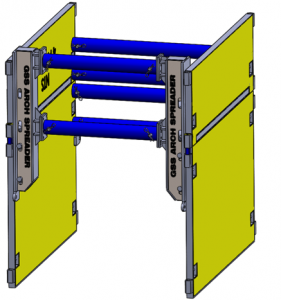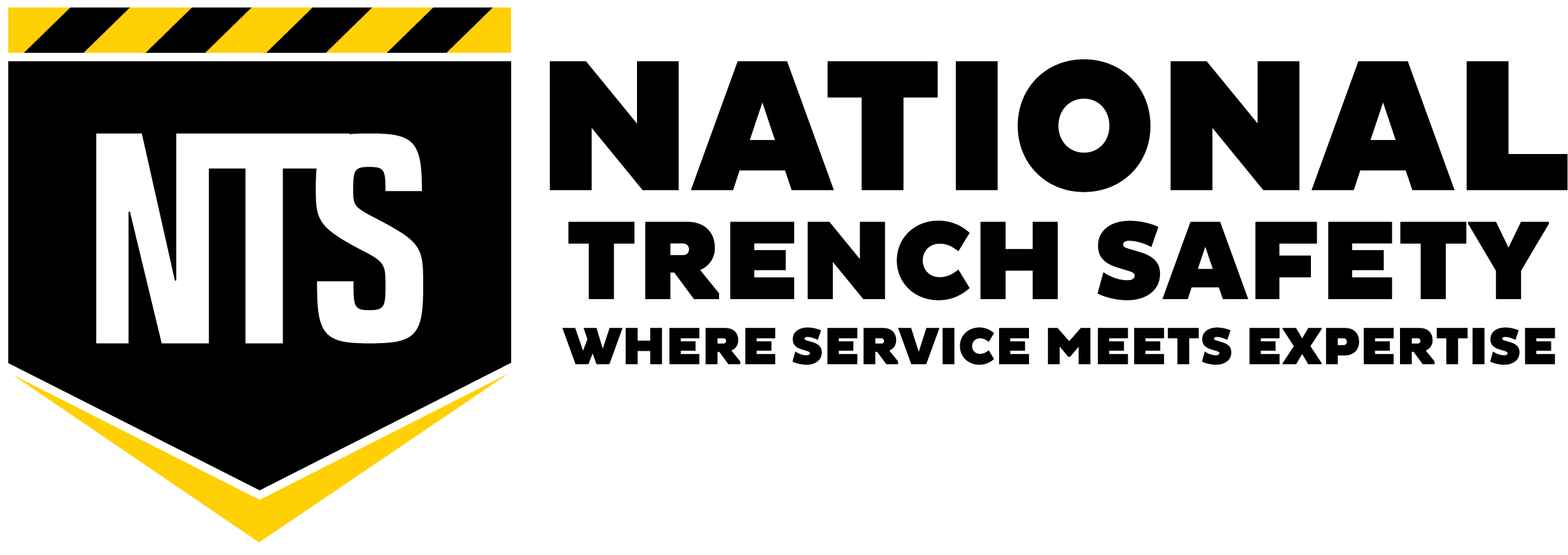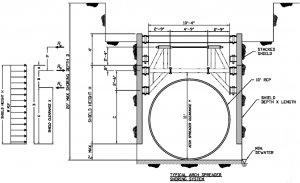Arch spreaders are used on shields for the specific purpose of raising the clearance from the underside of the shield spreader to the bottom of the excavation. Most often this is used for large-diameter pipe and box culvert installations. Typically, clearances can be raised from 5 ft to 8 ft with the use of an arch spreader. Depending on the application and manufacturer’s tabulated data, it’s possible that an additional 2 ft of clearance can be gained if the shield is held 2 ft off the bottom. The loads increase rapidly on the arch spreader as the clearance is increased, the practical limit is a clearance increase of 4 ft. Arch spreaders can be used on each end or one end of the shield.
 Arch spreaders do not change the strength of the shield in any way. The load path on a shoring shield takes the load from the soil to the shield wall. The shield wall carries the soil loads to each end of the shield and then the shield end beam `carries the load up the wall to the struts. The bottom strut is in compression and the top strut is in tension. As long as the arch spreader is connected to the shield strut receivers, generally speaking, the loads are exactly the same as if spreaders are attached to the shield. As a result of this, it is important to understand that:
Arch spreaders do not change the strength of the shield in any way. The load path on a shoring shield takes the load from the soil to the shield wall. The shield wall carries the soil loads to each end of the shield and then the shield end beam `carries the load up the wall to the struts. The bottom strut is in compression and the top strut is in tension. As long as the arch spreader is connected to the shield strut receivers, generally speaking, the loads are exactly the same as if spreaders are attached to the shield. As a result of this, it is important to understand that:
- As long as the receivers fit the arch spreader it makes no difference to the manufacturer or the strength of the shield (subject to any disclaimers in the manufacturer’s tabulated data)
- The strength of the shield and the tabulated data for the shield govern the use and allowable depth of the shield.
- The tabulated data for the arch spreader governs the use and allowable depth of the arch spreader.
- The least allowable depth of the shield or the arch spreader governs how deep the shield can be set.
Tables 1 and 2 below give the allowable depths for National Trench Safety GSS series Arch Spreaders. On the datasheet, the allowable depth is defined as the distance from the top of the excavation to the bottom of the excavation. The shields may be set up to 2 feet off the bottom, in conjunction with the manufacturer’s tabulated data, but it should be remembered that the arch spreaders add significant weight to the assembly. In soft soils, this can lead to one end of the box sinking into the bottom of the excavation.
Shields can be stacked on top of shields equipped with arch spreaders. For 4-ft tall shields, the shield spreader receivers are often encumbered by the arch spreader from the bottom shield. The GSS arch spreader shown above has holes for the receivers to fit into. Another way to handle the problem is to use an arch spreader that is tapered in at the top. Stacked shields should always be pinned in accordance with the shield-tabulated data. Figure 2 below shows another type of arch spreader and loading assumptions.
Arch spreaders are constructed from heavy steel beams and are situated above the shield. As a result, there are a few safety issues that the competent person should be aware of.
- The standard pipe spreader should be installed before installing the arch spreader because it will help to stabilize the box walls while the arch spreader is being installed.
- The single spreader box walls must be stable before setting the arch assembly. This may require a second excavator or another piece of heavy equipment. Due to the mass of the arch spreader assembly swinging and bumping it into the shield can cause damage or tipping. The arch spreader should have tag lines and workers should not be around it as it is being it is hoisted and guided to the top of the shield.
- With short shields (for example lengths of 8 ft, 10 ft, and 12 ft) due to the high center of gravity and weight of the arch spreader, there is a danger of tipping the shield onto its end. The excavator operator that is manipulating the shield while positioning it or dragging it should be made aware of this hazard.
- Shield pulling should only be done by pulling eyes below the top of the shield and never by pulling on the top of the arch spreader.
- Pins and spreader connections should be closely checked on a daily basis because they see increased wear and tear, again due to the high center of gravity of the arch spreader.
A complete job hazard analysis and safe means and methods procedure should be conducted for the shield high arch assembly operation and again for the in-trench operation. Heavier equipment that is required for normal shield operations should be anticipated.
DISCLAIMER: the information contained in this article is provided for general and illustrative purposes only and is not to be considered Site Specific and or designated engineering for any project or work zone, nor is it to be used or considered to be tabulated data, technical data, advice and or counsel to be used on any job site. Each project is different and is the responsibility of the employer’s designated Competent Person to make decisions on what systems and methods may be used in compliance with federal and local regulations, manufacturers tabulated data, engineered drawings, and other plans. The ideas, concepts, and or opinions expressed in this article are those of the author and not necessarily reflective of NTS’s position or view of a topic in all cases.









